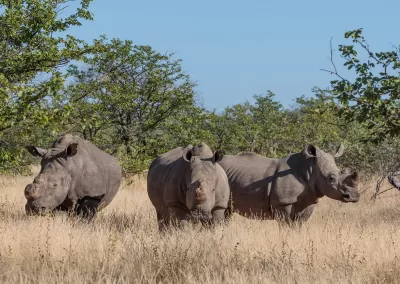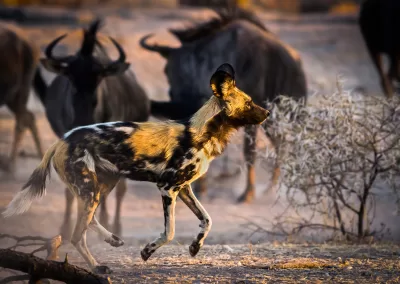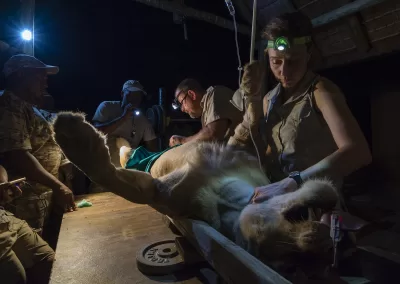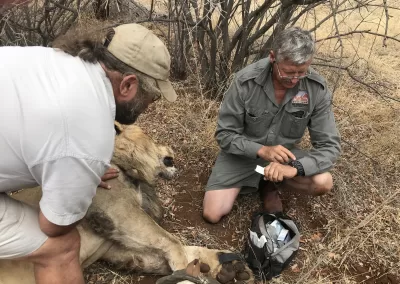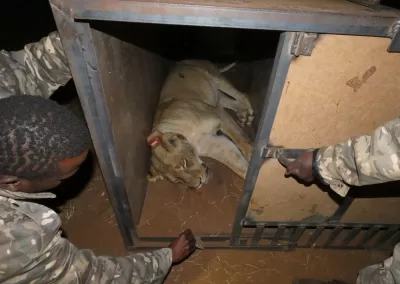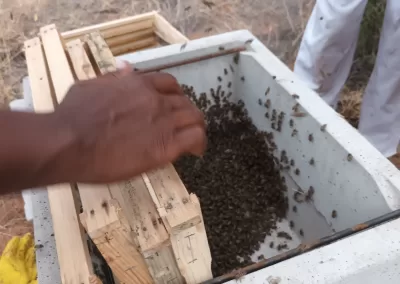Conservation
The key to our conservation efforts is a detailed Reserve Management Plan that has been developed based on scientific analysis and the application of best management practices. The principal elements of this plan include habitat restoration and veld management, species reintroduction and wildlife management and ongoing research.
In addition to our dedicated staff, there are ample opportunities for a co-owner to become involved in our conservation efforts. We recognise that co-owners come from diverse backgrounds – many are dedicated conservationists and can make direct contributions, others simply wish to enjoy the natural environment that the Reserve offers. Co-owners can, therefore, choose to contribute through a variety of ways including simply sharing photographs and logging species sightings with our bespoke App during game drives, or by partaking actively in specific surveys or projects.
Species Reintroduction
The Reserve worked hard to rehabilitate a litter of rescued wild dog pups and reintroduced them to the wild. The release occurred in late 2010, and we are proud to say that we have a healthy, well-established pack of wild dogs roaming the Reserve that are breeding well.
Research
To quantify and identify the nocturnal and shy species – especially predators like leopard, hyena, genet, and caracal which are difficult to spot during an aerial game count – a program of regular and large camera trap (motion-triggered) surveys is being implemented.
Eco-Supporters
To engage foreign interest, we have established an Eco-Supporters program through which volunteers from abroad can participate in conservation work on the Reserve, combined with research activities and community projects (VIEW MORE).
The program offers a once in a lifetime first-hand experience of the African wilderness.
When not helping in conservation tasks such as removal of undesirable invasive weed species, our Eco-Supporters could be tracking African Wild dogs using telemetry technology. We also offer interactive lectures/talks on the ecology, geology and conservation projects of the Reserve.
Volunteers stay at the Eco-Supporters camp, where they can share their experience with like-minded people from all over the world, while also being close to nature and learning about wildlife conservation.
ANTI-POACHING UNIT FOR WILDLIFE PROTECTION
APU FOR WILDLIFE PROTECTION
A key element of our wildlife protection effort is our Anti-Poaching Unit (APU) which is supported by members of the Botswana Defence Force, who are permanently stationed on the Reserve.
The APU among others monitors all the rhinos on the Reserve on a 24/7 basis. Furthermore, all our rhinos are dehorned every year and have been micro-chipped. We are in the process of implementing technology to monitor their location remotely.
As part of our community upliftment program, members of our APU visit the local schools in order to teach children about the value of conservation.
Lion Relocation
In 2021, we translocated eleven lions and left only three (2 males and 1 lioness) as a base for future development. The translocation process involved sedating the lions, loading them in metal cages and transporting them for a 15-hour trip to northern Botswana. Once there, several were fitted with radio collars to monitor how they were adapting to their new habitats. The results showed that the lions ranged over far wider areas in northern Botswana than had available to them within our Reserve.
Elephant Relocation
We continually monitor the population of elephants on the Reserve by conducting aerial surveys and recording fence breaks both-ins and outs. Transient elephants across the Greater Limpopo valley continue to find refuge in our reserve as they are often persecuted elsewhere. Managing these elephants comes at an enormous environmental and monetary cost to the Reserve.
Camera Trap Study
We conducted the inaugural camera trap survey in May 2022 and a subsequent one in 2023 as part of a five-year program of annual surveys. The results captured some species that are often not visible on game drives such as pangolin, caracal and aardwolf. We also found a lot of smaller cat species like genets, civets, and black footed cats across the Reserve. A quantitative analysis of the data will give us insights on densities of impact predators such as hyenas and leopards. Our goal is to conduct annual surveys as they will ultimately show population trends of such cryptic species in the long term.
Veld Rehabilitation
Over the past 5 years, we have begun to implement a veld restoration program which involves bush clearing, reseeding and controlled burning. The effort is ongoing, but the results are already apparent. New healthier grass varieties have begun to reappear, and grazing capacity has increased substantially. This process will take several years before a balance is struck.
Bee Boundaries
As it turns out elephants are not easily scared, but there is a tiny insect that makes elephants run… bees! As you can read under ‘elephant relocation’, at Limpopo-Lipadi we see quite a few elephant break-ins, seeking refuge in our Reserve. Installing beehives as a gentle way to discourage elephants to break down our fences, seems a logical step as an elephant break-in mitigation measure. But that not alone: Limpopo-Lipadi’s beekeeping project is also formulated to empower the local community.
We have placed 20 beehives along the southern fence of the reserve, where we have been experiencing reoccurring elephant break-in. Capacitated and trained community members are the drivers of the project. In return, they benefit from shared revenue created from the sale of honey and by-products. With the skills gained, we then encourage them to venture into beekeeping as a small-scale business.
Interested?
As a co-owner you will be briefed on the progress of these studies and have the opportunity to speak with our own Research Manager to learn more as well as to get directly involved in projects. Shareholder-supported and -led projects include:
- Camera trap studies
- Flora surveys
- Development and management of game recording app
- Animal reintroductions
Going forward we are collecting a vast amount of data which needs to be analysed and we have camera traps which can be used to collect yet more data.
As an Eco-supporter you can get a taste of what is required to conserve the flora and fauna of the African bush whilst helping to fund further research.
You can also help support future studies and conservation efforts by donating to Motse Community and Wildlife Conservancy fund and specifying whether you wish the funds to be used on community or conservancy projects.

